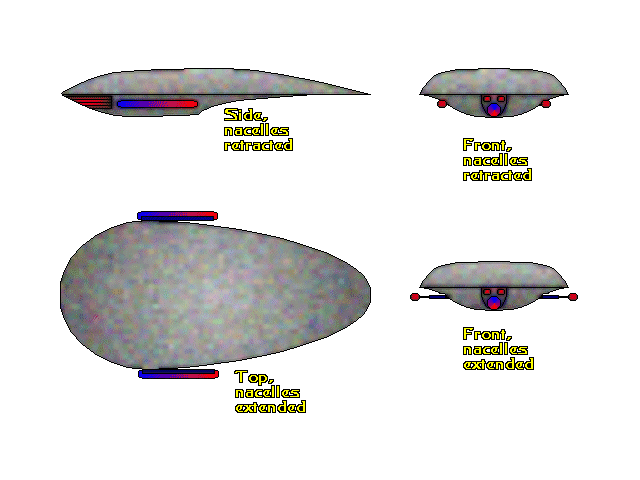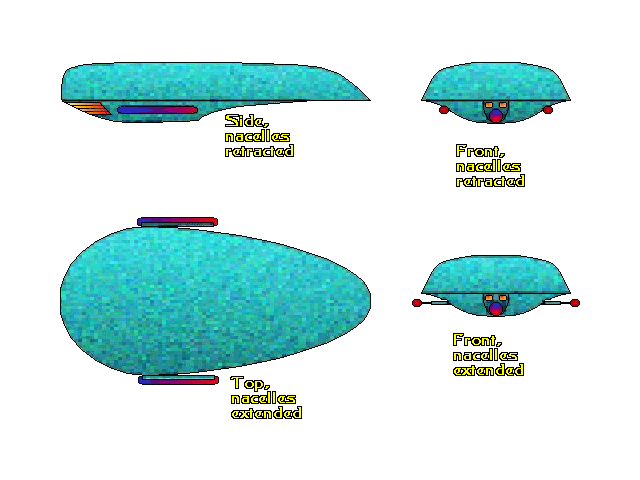

Type II Executive Shuttle
General Specifications:
Length: 25.9m
Width: 12.5m
Height: 4.1m
Max Warp: 9.95
Cruise: 9.0
Max Impulse: 0.75 lightspeed
Crew: 3, plus up to 8 passengers.
Armaments: One phaser cannon coupled to the phased array; two enhanced quantum torpedo racks (fwd), each capable of firing two torpedoes.
Type: Executive Shuttle
Status: Type II executive shuttles (ESII) are being constructed on an as-required basis. Eventually, Starfleet intends to provide one ESII to all starships with a primary or secondary diplomatic mission, as well as equipping all starbases with one ESII for each flag-ranked officer normally assigned.
About Ship: When the Galaxy class starships were designed, they incorporated a "captain's yacht", presuming (correctly) that there would be times when the captain might require more impressive transportation than a common shuttle. Unfortunately, while the captain's yacht was a noble experiment, it was considered a nonessential component, and consequently, several design faults went unnoticed until several Galaxy class vessels were constructed. The captain's yacht had serious problems with its artificial gravity systems and inertial dampers. Those already constructed had the drives and bridge removed and were plasma-welded in-place as VIP quarters. Subsequent Galaxy class vessels were constructed with VIP quarters instead of the captain's yacht.
An interim solution arrived in the form of the Type I executive shuttle. These were converted from large standard shuttles with upgraded interior appointments. While adequate, they didn't have the "cachet" that a unique vehicle would. Since other concerns demanded the majority of Starfleet's attention, the problem of a suitably impressive Captain's yacht was given no official attention.
Meanwhile, a new fighter design, the Chevalier, began entering service. Although cramped, it had the saving grace of being new and unique. An additional advantage to this vehicle was the designed-in ease of modification. The Commodore in charge of the Chevalier project had been a key player in the design of the SARPEV Mk II, and decided to modify one of the Chevalier spaceframes to provide some additional passenger space "purely as a design study".
The ESII (pronounced "easy") is essentially a Chevalier with some of the armaments stripped out and a larger upper hull shell. The ESII retains many of the features of the Chevalier, but has sufficient internal volume for 8 additional passengers. Quarters are still somewhat tight, but well-appointed and nowhere near as claustrophobic as the Chevalier. The ESII is as long and wide, and half the height of a Danube-class runabout. It has approximately one third the internal volume of a Danube class runabout, due to its low profile.
The hull of the ESII incorporates holographic hull emitters, providing a chameleon-like ability to adjust hull reflectivity and emissivity. This affords the ESII a fair imitation of cloaking without massive power consumption. This makes it extremely difficult to detect and makes a positive weapons lock-on nearly impossible. It does not, however, confer true cloaking ability. The hull is devoid of markings that would help an enemy determine weak spots. The holographic hull surface actively displays desired hull markings such as registry numbers, vessel name or distinctive insignia. The hull also incorporates a multifunction phased array. This array is an integrated network of emitters and sensors imbedded directly within the hull matrix itself, including sensors, phaser emitters, deflector emitters, and tractor beam emitters. The array can take a significant amount of damage before performance is significantly diminished. An added benefit of the phased array is a profound increase in sensor acuity and range, due to the large size of the array (as big as the hull). The sensor array provides the ability to precisely target objects 1 meter in diameter at a distance of just under 4 astronomical units. Dual micro-M/ARA units provide power, supplemented by a battery of quantum flywheels. The flywheels store several days' worth of M/ARA output for emergency or combat use, allowing the vessel's power consumption to temporarily exceed generation capacity by several orders of magnitude.
Executive Runabout:

Type II Executive Runabout
General Specifications:
Length: 24.8m
Width: 12m
Height: 5m
Max Warp: 9.5
Cruise: 8.85
Max Impulse: 0.75 lightspeed
Crew: 3, plus up to 12 passengers.
Armaments: One heavy phaser cannon of classified output coupled to the phased array; two enhanced quantum torpedo racks (fwd), each capable of firing two torpedoes.
Type: Executive Runabout
Status: Type II Executive Runabouts (ERII) are being constructed on an as-required basis. Starfleet plans to provide one ERII to all starships with a primary or secondary diplomatic mission, as well as equipping all starbases with one ERII for each flag-ranked officer normally assigned. Although the ERII has superceded the type II executive shuttle (ESII), all type II executive shuttles will remain in service until they would normally be retired.
About Ship: When the ESII entered production, the one complaint immediately and repeatedly voiced about that design was that although luxurious, the ESII was quite cramped. Many sentient species within the Federation are quite tall, and the ESII provided a truly claustrophobic environment, with a maximum deck-to-overhead height of only 2 meters. Starfleet halted ESII production while a cost-effective solution to this problem was sought.
Once again, the inherent adaptability of this basic design came to the rescue. The type II executive shuttle was modified to become the Type I executive Runabout. The Type I executive Runabout added a 1-meter "girdle" between the upper and lower hull sections to achieve an acceptable deck height, however, this resulted in poor hull integrity and it never entered production. The type II gained the desired depth of hull by replacing the entire upper upper hull section half with a taller shell. The interior appointments were then rearranged to take advantage of the additional height. Passenger capacity was increased to 12, though the usual total is expected to remain around six.
Sublight performance remains the same as the ESII, but warp geometry was adversely impacted. Top warp speed is limited by structural stress, and cruise speed is also lowered, compared to the ESII. In all other respects, the ERII is a roomier version of the ESII. Starfleet has decided that a lower maximum warp is acceptable in a diplomatic vessel of this sort.
Return to the Starship Catalogue.